chapter 4
look outside the frame

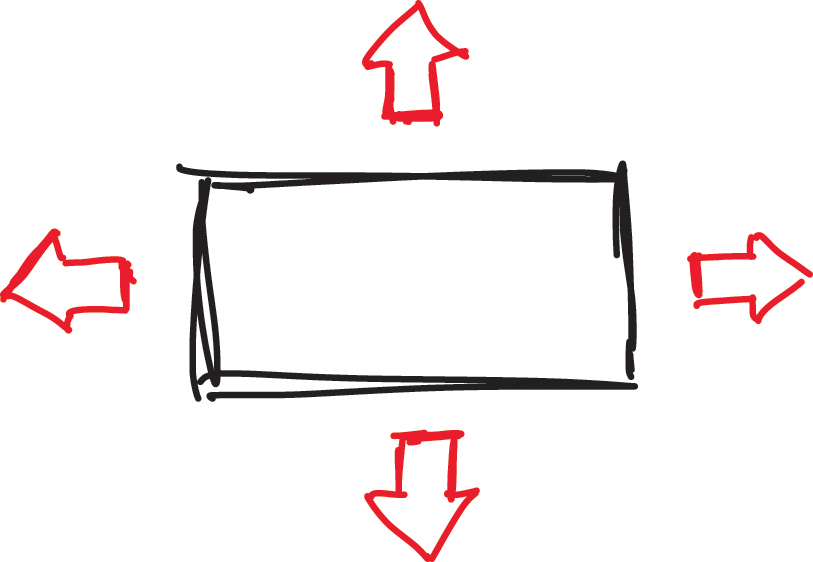
A QUICK CHALLENGE


In the 19th century, the French mathematician Édouard Lucas posed a problem to some of his colleagues. The problem required no math skills and could be solved in less than a minute, and yet, none of his colleagues got it right.
Can you do better than the professional mathematicians? And just for good measure, this is not a trick question. You don’t have to creatively reinterpret the words, turn the book upside down, or look for secret writing by dipping the page in lemon juice.*
Don’t read beyond this page until you are ready for the answer. (And if you can’t be bothered to think it through in detail, just make a quick guess.)
The New York–Le Havre problem
The shipping company Bonjour operates a direct sailing route between New York and the French city Le Havre, with one departure each day in both directions. Specifically, every day at noon in New York, a ship sails to Le Havre, and simultaneously in Le Havre, a ship sails to New York. The crossing takes exactly seven days and seven nights in either direction.
The question is: If you leave New York on a Bonjour ship today, how many other Bonjour ships will you pass at sea before you arrive in Le Havre?* You should count only the company’s ships, and only the ones met at sea (meaning not in the harbor).
* * *
Ready for the solution?
Some people guess either six or eight ships. After some careful thinking, though, most people conclude it must be seven ships—so if that was your answer, you’re in excellent company.
Sadly, you’re also wrong, because the correct answer is none of those—it is thirteen ships. Yes, thirteen. I’ll explain in a minute.
The danger of a limited frame
The New York–Le Havre problem illustrates a common pitfall in problem solving: the danger of framing the problem too narrowly.
In short, we don’t come to problems with a neutral view of the situation. On the contrary: in messy situations, it’s as if your subconscious mind immediately draws a frame around a specific part of the problem before passing it on to your conscious self.
This first framing carries profound consequences. Everything within the frame is carefully scrutinized. Everything outside the frame, however, receives zero attention. In fact, because the framing process is largely subconscious—researchers have used the term “automatic”—we usually aren’t even aware that we’re not seeing the full picture.
Here’s how that plays out in the New York–Le Havre problem.*
Counting ships
Most people think through the problem more or less like this:
- Our trip takes seven days and nights, so we can figure out that a total of eight ships leaves Le Havre in that period. (One way to check this is to list the weekdays—you’ll see a drawing of that on the next page.)
- We must meet all of those ships at sea, except for the 8th and final ship. That one launches just as we arrive in the harbor, so we don’t count it, for a final answer of seven ships.
The calculation is correct, but it is also incomplete: we’ve missed the ships that sailed before our departure and are already at sea when we leave New York. The incomplete framing is shown below, followed by the correct framing.


Incomplete framing: 7 ships


Correct framing: 13 ships
Now, if you got it right, congratulations! A certain level of smugness and gloating is entirely in order. But if you got it wrong—and most people do—you should pause and reflect: Why did you miss those six ships? After all, it’s not as if the challenge was presented in a completely innocuous context. You’re reading a book on problem solving whose main point is that we don’t frame problems correctly. With a setup like that, you know that there’s a catch somewhere.*
To understand why people get it wrong, it’s necessary to realize that there is more at play than the unconscious framing effect. Significantly, with the New York–Le Havre problem, there are also highly “visible” problems to ponder inside the frame, attracting the attention of our problem-crunching minds. Inspecting the initial framing, our minds are immediately drawn to questions like, Hmm, is it seven or eight ships that launch during the week? How about the last one, I guess we meet that one in the harbor? Maybe I should count them, just for good measure. [Pulls out trusty fingers; starts counting.]
Because there are some evident issues to grapple with inside the frame, we happily jump into thinking about those, while forgetting to ask if there are parts of the problem that we’re not paying attention to at all.
The strategy: look outside the frame before you dive in
How do expert problem solvers avoid this trap? They deliberately avoid delving into the details of what’s in front of them. Instead, they mentally “zoom out” and examine the larger situation, asking questions like, What’s missing from the current problem statement? Are there elements we’re not considering? Is there anything outside the frame that we are not currently paying attention to?
The habit of zooming out is used by experts in many different fields. In a study of expert designers, for instance, the design scholar Kees Dorst found that when working with clients, the expert designers “do not address the core paradox head-on, but tend to focus on issues around it. They search the broader problem context for clues.”*
Doctors do the same. As described in Lisa Sanders’s book Every Patient Tells a Story (an excellent introduction to diagnosis in medicine), good doctors don’t just focus on the stated ailment.* They take a holistic view of the patient, their symptoms, and their history. In so doing, those doctors spot clues other doctors have missed, sometimes for years or decades.
Experts in operations science also practice zooming out. Inspired by the influential discipline called systems thinking, problem-solving experts in areas like manufacturing and workplace safety are trained to look beyond the immediate cause of an incident, searching for higher-level, systemic causes.* Yes, the dog ate your homework. But who left the homework in her bowl, sprinkled with dog chow?
All of those approaches share the central concept of looking outside the frame before delving into the visible details. Here are four tactics that can prevent you from framing the problem too narrowly.
1. LOOK BEYOND YOUR OWN EXPERTISE

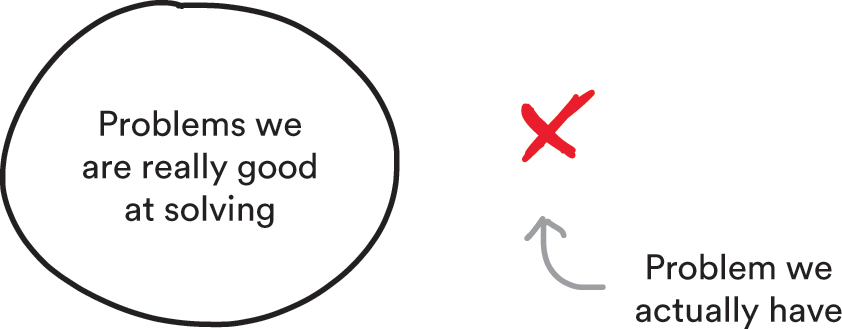
In his 1964 book The Conduct of Inquiry, the philosopher Abraham Kaplan coined what he called “the law of the instrument”: “Give a small boy a hammer, and he will find that everything he encounters needs pounding.”*
Kaplan’s delightfully memorable law came not from studying the feral children of carpenters but from his observations of scientists. Specifically, he found that scientists often framed a problem to match whatever techniques they were most proficient in.
They are not the only ones. Most people have a tendency to frame problems to match their own “hammer,” hewing to the tools or analytical perspectives they favor. In some cases, that default solution simply doesn’t work, which possibly—eventually—leads them to reconsider their approach. A potentially worse outcome, though, is when the favored solution does work, but by unthinkingly defaulting to their hammer, they fail to spot a much better way forward.
Here is an example from my work with a team of senior executives in Brazil.* The team was asked to provide their CEO with ideas for improving the market’s perception of their company’s stock price.
Drawing on their financial expertise, the team quickly listed the various levers that influenced their stock price: the P/E ratio forecast, the debt ratio, earnings per share, and so on. Of course, none of this was news to the CEO, nor were these factors particularly easy to influence, leading to mild despondency on the team. But when I prompted the executives to zoom out and consider what was missing from their framing of the problem, something new came up.
(If you want to try and guess along, pause here and consider what the team came up with. Here’s a hint: the insight came from an HR executive.)
* * *
The HR exec asked, “Who talks to the analysts?” When external financial analysts called the company asking for information, they were typically put in touch with slightly more junior leaders—none of whom had received training in how to talk to analysts. As soon as this point was raised, the group knew they had found a new potential recommendation for the CEO.

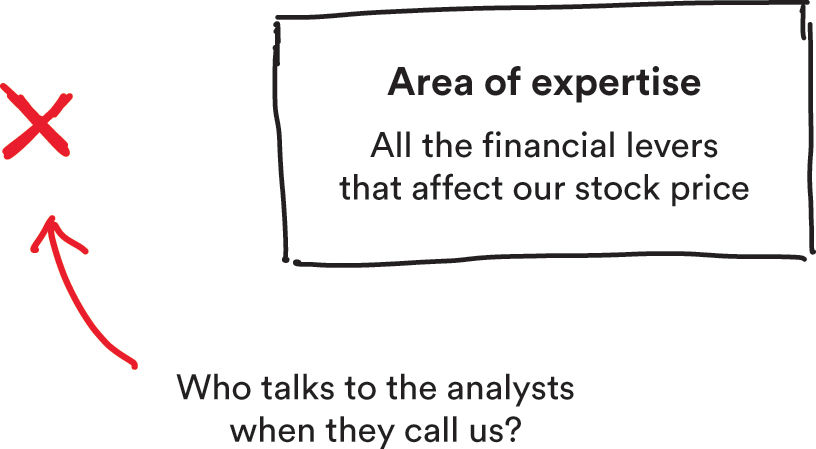
The story also illustrates the power of inviting outsiders into the reframing process. Since the stock price issue clearly seemed to be a financial problem, it might have been tempting to include only finance-savvy people in the meeting. The decision to include the HR executive (who was not a finance expert) brought a more people-oriented lens to the problem, allowing the team to look beyond the finance framing.
Merely having outsiders in the room isn’t always sufficient, however. You have to actively invite them to come up with alternative framings. The strategy of zooming out and asking what’s missing is one powerful way of doing so.
Letting go of your hammer
A quick remark on Kaplan’s law of the instrument: it’s not necessarily bad to have a default solution. Yes, there are situations in which blindly going with your default is problematic—for example, when you have only one shot at getting things right, or when your go-to solution can potentially cause harm when wrongly applied.
Except for these scenarios, though, it’s not always a mistake to reach for the hammer you know best. On the contrary, we often have a preference for a specific tool precisely because it has worked well in the past, on most of our problems. Facing an unknown problem, it can be entirely logical to start with the tool you know best.
The real mistake happens when you keep using the hammer even after it’s clear that it’s not working. My spouse is never ready to leave the house on time, no matter how much I yell at them. Hmm, maybe I should try some more yelling next time. The first fifty failures could have been statistical aberrations.
If the problem you are facing is one you’ve repeatedly failed to solve with your preferred solution, then there’s a good chance you need to reframe the problem. As the crime writer Rita Mae Brown put it: “Insanity is doing the same thing over and over again, but expecting different results.”*
2. LOOK TO PRIOR EVENTS

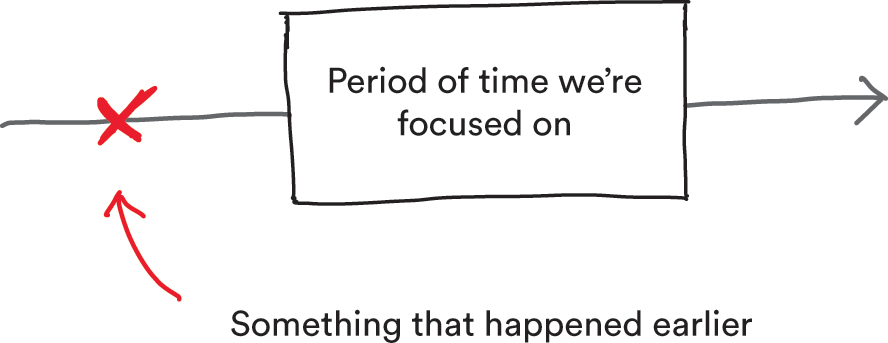
Consider how you would respond to this situation:
Your teenage daughter comes back from school early, visibly upset. When you ask what’s going on, she explains that she got into a shouting match with her teacher. The fight escalated to a point at which your daughter stormed out of the class. This is not like her: she’s normally fairly well-behaved.
What questions would you ask your daughter to better understand the issue?
In situations like these, parents typically zoom in on the “visible” details: “How did the fight start? What did your teacher say? How did you respond? Why did that make you so upset?” Based on this granular analysis of the conversation, conclusions are drawn. My daughter is becoming more rebellious; I guess she’s a typical teenager after all. Or maybe the blame shifts toward the teacher: As the adult in the room, shouldn’t he have been capable of handling the situation better? The school really needs to find better teachers!
If you ask professionally trained school counselors, however, they will likely ask your daughter a different question: “Did you remember to eat breakfast this morning?”* Surprisingly often, the difference between a civilized discussion and a huge fight lies in whether the people involved are running on an empty stomach. (Another popular variation is getting too little sleep.)
Like the ship counting problem, the breakfast example shows that you can sometimes shed new light on problems by noticing what happened before the slice of time you are currently focusing your attention on.
- What happened last time one of our employees tried to innovate?
- Which solutions did our client try to apply before coming to us?
- What happened to the last group of teenagers that rented this remote cabin in the woods?
The approach can be overdone, of course. Go too far back, and you end up contemplating deep historical factors that are hard to change. Still, consider whether you are framing the problem too narrowly from a time perspective.
3. LOOK FOR HIDDEN INFLUENCES


If you ask an academic about logical pitfalls, you’ll probably hear the phrase mistaking correlation with causation. Just because two things tend to occur together doesn’t necessarily mean that one actually causes the other. Often, there is a third, underlying factor that’s the real culprit. (Scientists call this a “confounding variable.”) Here’s an example.
What did the marshmallow test really show?
If you read popular science books, chances are you have already heard about the marshmallow test. In the experiment, Stanford psychologist Walter Mischel and his team put young kids in front of a marshmallow, one at a time, and told them, “If you refrain from eating this marshmallow for fifteen minutes, I’ll give you a second marshmallow.” And then they left the room and secretly watched what happened.
Mischel and his colleagues argued that the kids’ ability to delay gratification was strongly predictive of their success as adolescents. Kids that resisted the temptation went on to become high-achieving, healthy young men and women. The low-willpower kids, not so much: they were less healthy and fared less well on a series of other measures too.


Lesson learned: to make kids succeed, teach them willpower. Only, was that really what the study showed?
According to a recent study by Tyler Watts, Greg Duncan, and Haonan Quan, there is more to the story. Mischel and his colleagues had run the original study on 90 preschoolers, all of them from Stanford’s campus. In the new study, Watts and his colleagues tested the theory on 900 children—and, crucially, they made sure to include children from less privileged backgrounds.
The result: It wasn’t really about willpower. It was about money.

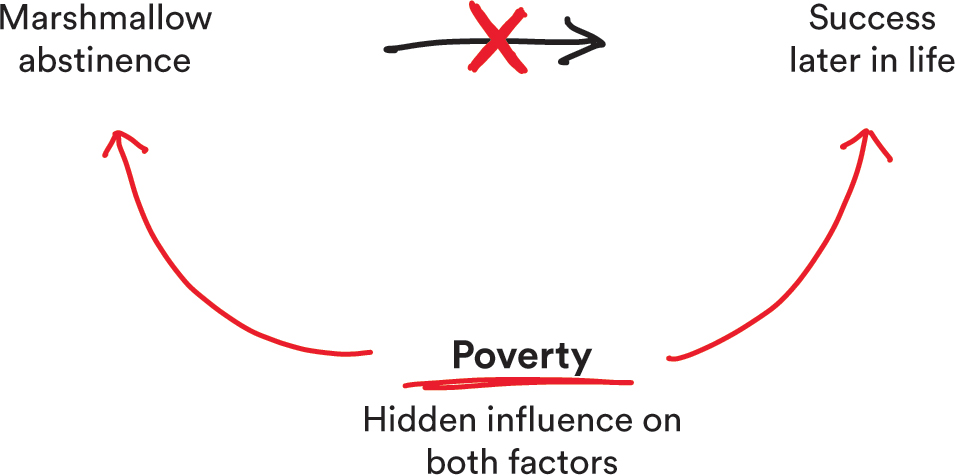
The full explanation is nuanced, but here’s the essence of it: Poor kids gobbled down the marshmallow faster because they had grown up in environments in which food might not be around tomorrow, and in which the grown-ups couldn’t always keep their promises. Better-off kids, in comparison, were used to a more predictable future, one in which food was never scarce—and they knew from experience that adults generally kept their promises.
When the researchers factored this in, the link between marshmallow abstinence and future success became much less clear.* If you want to help kids succeed, it’s not necessarily about teaching them to delay gratification; it is about improving their socioeconomic conditions.
Here’s a business example of finding hidden causal factors, shared with me by a finance executive we’ll call Pierre. Pierre was asked to look into the interview process at his company, a major bank. The bank had a great brand and received lots of job applications from very talented people. However, many of the candidates the bank interviewed ultimately chose not to work there.
Initially, the team examined several factors: Were the interviews too grueling? Were the pay packages not competitive? Did it matter, perhaps, who conducted the interviews from the bank’s side? None of those theories seemed to explain the pattern.
The mystery was solved only once Pierre looked outside the frame and found a hidden factor: the interviews with high rejection rates all took place in the bank’s old office building. The candidates who were interviewed in the bank’s new, more modern building, in comparison, loved the firm and generally made it their first choice. From that point onward, candidates were shown the old offices only after they had signed the contract and the bank vault had clanged soundly shut behind them.
4. LOOK FOR NONOBVIOUS ASPECTS OF THE SITUATION
The last two tactics I covered, looking for prior events and hidden influences, are really two different versions of the same thing—namely a search for causal factors.
Causes like those are not the only kind of elements that can be “hidden” outside the frame. Sometimes, finding the nonobvious solution hinges on thinking carefully about the properties of an object or a situation. Consider this classic challenge from the world of problem solving.
The light bulb problem


There are three light bulbs in the basement of your new house, but for some reason, the switches are located on the ground floor—and they aren’t labeled. You have a sore knee, so you’d prefer to minimize the number of times you have to use the stairs. The question is: How many trips do you have to make into the basement to figure out which switch works with which light? For the record, the lights all work, each switch affects only one light bulb, and all three light bulbs are turned off when you start.*
Pause here if you want to try to solve this.
* * *
If you gave it a bit of thought, you probably realized that you can do it in two trips. The third trip is unnecessary, as you can figure out the last match by a process of elimination. So far, so good.
But—there is also a way to solve it in one trip. Can you figure out how? Again, this is not a trick question, and it doesn’t involve crazy stuff like drilling holes, tweaking the wires, or setting up elaborate systems of mirrors. The solution is simple and realistic and does not involve items or people that aren’t mentioned in the problem statement.
Give it a try—but be warned: this one is harder to figure out. If you need a hint, I can tell you that the one trip solution relies on a nonobvious feature of one of the things that are involved. Think about what other properties a light bulb has besides emitting light.
The one trip solution
Here is the one trip solution to the light bulb problem:
- Turn on two of the switches.
- Wait one minute.
- Turn one switch off again.
- Go downstairs and feel the two unlit light bulbs. One of them will be warm to the touch.
If you are like most people, you found this solution to be a lot less obvious than the two-trip solution. And yet, everybody knows that light bulbs get warm when they are turned on—so why is this solution so much harder to find?
Frames allow us to see …
Because our subconscious mind tries to be as efficient as possible when it frames a problem—some researchers call the brain a cognitive miser—it allows only what it deems the most essential features to be included in the framing.*
When mulling over the light bulb problem, for instance, you probably didn’t stop to imagine the color of the wallpaper or whether it was summer or winter. Neither of those things seemed to have relevance for solving the problem, and so, quite sensibly, your mind simply didn’t bother to think about them. Instead, it created a simplified representation of the problem—that is, a mental model—that you then started playing around with, throwing switches and whatnot until you found a solution.
… and frames blind us
This simplification is a good thing. Without the ability to quickly zoom in on the essential parts of a problem, we would be stuck thinking endlessly about wallpaper, to the delight of house decorators everywhere. But it also means that potentially useful elements or properties of the real world get left out.
A contributing factor is something called functional fixedness, which describes our tendency to focus only on the most common uses for things (light bulbs create light) and overlook less obvious uses (light bulbs can be used to create heat).*
To identify such hidden aspects, ask questions like:
- What objects are involved in the situation?
- What other properties do they have? Can they be used in nontraditional ways?
- What else do we have available?
Here’s a simple example of how a problem got solved by identifying and drawing on a hidden facet of the situation.
Imagine that you work as a parking attendant at Disneyland, managing the giant parking lot outside the theme park. Every day, more than ten thousand families arrive, park their cars, and head for the entrance.
Different areas of the massive lot are clearly marked so that people can find their vehicles when they head home: Our car is in the Donald Duck zone, section 7B. But every week, about four hundred sunbaked families, dazed by the experience and burdened by overstimulated kids in mouse ears, manage to forget where they left their car. How could this problem be solved?
A first observation might be that this type of problem has probably been solved before. (This is the essence of the “bright spots” strategy, which we’ll cover later.) If you look at delivery services like FedEx or perhaps container facilities in commercial harbors, you’ll find a number of solutions that use GPS tracking, license-plate scanning, and similar technologies.
Those would be expensive solutions here. Might there be a smarter solution that uses what’s available and doesn’t require new technology?
Yes. The parking attendants at Disney realized that there was one piece of information that people generally did remember, even if they forgot the parking-lot number: their arrival time.* As the journalist Jeff Gray put it in the Canadian newspaper The Globe and Mail: “Disney staff simply write down the times that each row of the lot fills up in the morning. As long as customers know when they arrived, Disney staff can find their cars.”
* * *
If you chose to work on your own problems as part of reading this book, now is the time to get to work. Pull out your written problem statements and try to apply the tactics to one or more of them. (It’s up to you to decide how much time to spend on this before moving on.)
If you didn’t choose to work on your problems, simply treat the next two pages as a chapter refresher, and ignore all instructions to review your problem statements.
CHAPTER SUMMARY
look outside the frame

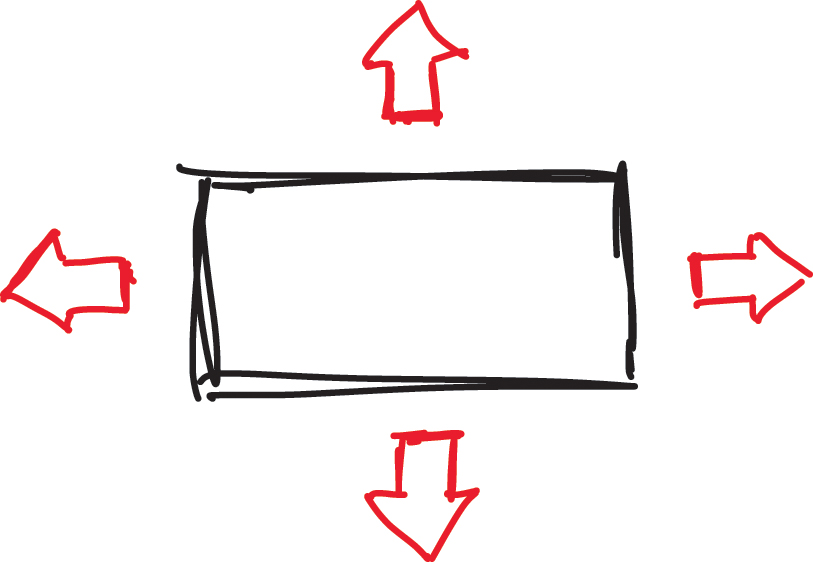
For each problem, remember to look outside the frame:
- Don’t get caught up in the visible details.
- Think about what might be missing from your current framing of the problem.
Once you have done a general review, try to apply the four tactics described in the chapter, summarized here.
1. Look beyond your own expertise
Remember the law of the hammer: we tend to frame problems so that they match our preferred solutions. In Brazil, the finance people focused on the financial metrics of the stock price, overlooking the communications aspect.
Consider the following:
- What is your own favorite “hammer,” meaning the type of solution you are good at applying?
- What type of problem does your hammer match?
- What if the problem was not such a problem: What else could it be?
2. Look to prior events
Recall the shouting match with the teacher in which a prior event may have caused the issue: “Did you eat breakfast this morning?”
Consider:
- How are you framing the problem from a time perspective?
- Did something important happen before the period of time you are looking at?
- For that matter, is there something after the time period that you missed? For instance, do people act a certain way because they fear a future outcome?
3. Look for hidden influences
Remember the marshmallow test and how the researchers overlooked the influence of poverty. Or think about how Pierre figured out the influence his bank’s office building had on recruiting.
Consider:
- Are there stakeholders whose influence you’re missing?
- Are there higher-level, systemic factors at play that influence the people involved?
4. Look for nonobvious aspects of the situation
Remember the light bulb problem, in which a less salient quality—that light bulbs emit heat—led to a more efficient solution than the one most people come up with.
- Are there nonobvious aspects of the problem or the situation that you could look into?
- Do you have data that can help you, or other things that are already available to us?
- How is functional fixedness affecting you?
Finally, are there other things “outside the frame” that you are not paying attention to? Incentives? Emotions? People or groups you have forgotten about? Briefly consider this, and then move on.